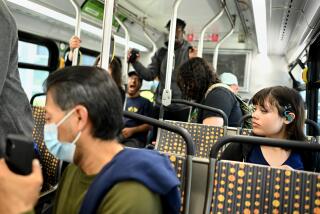Transportation
- Share via
Getting from here to there has sparked many inventions, including the wheel in 3500 B.C., which then led to chariots, bicycles, cars and the steam engine in the early 1800s used in ships and trains. As humans progress into space, transportation continues to be critical in daily lives. Learn more about different modes of transportation by using the direct links on The Times Launch Point Web site: https://www.latimes.com/launchpoint/
Level 1
Transportation: View photos that show ways to get around, from boats and horse-drawn carriages to bicycles, automobiles, trolleys and planes.
https://www.augustana.edu:80/library/trans.html
*
So You Want to Make a Car: The car’s “dashboard” gets its name from its predecessor, the horse-drawn carriage, which had a front panel to keep the driver from being “dashed” by flying rocks. Learn more about auto history, tour a modern manufacturing plant, find out about careers with cars, and try your hand at leading your own company.
https://www.ipl.org/autou/
*
The Science of Ballooning: A duck, a sheep and a rooster made aviation history in 1783 as the first passengers of a successful balloon flight conducted by Frenchmen Joseph and Etienne Montgolfier. Find out about ballooning’s colorful history and try some fun science activities.
https://www.pbs.org/wgbh/nova/balloon/science/
Level 2
To Fly Is Everything: See how Orville and Wilbur Wright developed the first aircraft through stories, photos, movies and even a computer simulation of the famous 1903 Kitty Hawk flight. Learn about other contributors to aviation history.
https://hawaii.cogsci.uiuc.edu/invent/airplanes.html
*
The Railroad Comes to America: The completion of the Transcontinental Railroad at Promontory Point, Utah, in 1869 meant that an overland trip that used to take four to six months could be completed in six days. Explore the history of the railroad in the United States.
https://www.csrmf.org/history
*
NOVA Online: Fast Cars: In 1983, Richard Noble drove a car, the Thrust II, at 639.803 mph. Find out how the development of fast cars to break land speed records has led to better, more aerodynamic designs for consumer.
https://www.pbs.org/wgbh/nova/fastcars/
Level 3
National Air & Space Museum Exhibit Galleries: In 1927, Charles Lindbergh flew his “Spirit of St. Louis” from New York to Paris in 33 hours, 30 minutes--the first solo nonstop transatlantic flight in history. This comprehensive site describes everything from the principles of flight and aviation milestones to turbojets, spacecraft and the myths behind “Star Wars.”
https://www.nasm.edu/NASMDOCS/NASMexh.html
*
The Mariners’ Museum: Ships have transported passengers and freight for thousands of years. Explore artifacts and photos from a variety of sea-oriented exhibits, from lighthouses and piracy to 100 years of ships, including a special feature on the Titanic.
https://www.mariner.org./galleries.html
*
California Smart Traveler: Be more knowledgeable about today’s transportation options by accessing local bus and train schedules, current highway and weather conditions, and various bicycling resources.
https://www.smart-traveler.com/
EXPLORER’S QUEST: What 1890 innovation in the Benz Victoria made it possible for cars to drive up hills?
CLUE: See “So You Want to Make a Car.”
Find What You Need to Know: Have a project on California history? Need help doing a math problem? Launch Point now covers more than 50 topics for getting your schoolwork done. Go to https://www.latimes.com/launchpoint/ for the full list of subjects and direct links to the best Internet sites.
Answer to last week’s Quest: RAM (random access memory) stores information temporarily while ROM (read-only memory) stores information that cannot be altered or lost.
*
Launch Point is produced by the UC Irvine department of education, which reviews each site for a ppropriateness and quality. Even so, parents should supervise their children’s use of the Internet. This week’s column was designed by Anna Manring.
More to Read
Sign up for The Wild
We’ll help you find the best places to hike, bike and run, as well as the perfect silent spots for meditation and yoga.
You may occasionally receive promotional content from the Los Angeles Times.






